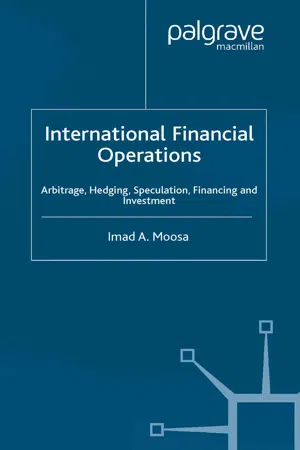Business
Hedge Ratio
The hedge ratio is a measure used to determine the amount of hedging needed to offset the risk of an investment. It involves calculating the ratio of the value of the investment being hedged to the value of the hedging instrument. This helps businesses manage their exposure to price fluctuations and minimize potential losses.
Written by Perlego with AI-assistance
Related key terms
1 of 5
3 Key excerpts on "Hedge Ratio"
- eBook - ePub
Multi-Asset Risk Modeling
Techniques for a Global Economy in an Electronic and Algorithmic Trading Era
- Morton Glantz, Robert Kissell(Authors)
- 2013(Publication Date)
- Academic Press(Publisher)
As stated, the Hedge Ratio of a portfolio is defined as the value invested into the hedged position compared to the value of the original portfolio. For example, if the current portfolio has a value of $100 million and the manager hedges the portfolio using $50 million of a futures index, the Hedge Ratio is calculated as:Notice that in this calculation the ratio is not the hedged position divided by total dollar value invested by the manager of $150 million (e.g., $100 million invested in the portfolio plus a $50 million value invested in the futures index equals $150 million). That is, the Hedge Ratio is not $50 million/$150 million=1/3.It is important to distinguish the difference in the Hedge Ratio calculations to ensure proper hedging values and weighting schemes. Different authors and different practitioners may denote the Hedge Ratio using different denominators. That is, depending upon the context of the study, the Hedge Ratio from the previous example may be stated as h=1/2 or h=1/3. While the definition we provided is the true and universally accepted definition, this, unfortunately, is not used consistently throughout the industry. Analysts are always encouraged to verify the definition being used by the researcher.The optimal Hedge Ratio is defined as the proportion of portfolio dollars to invest into the hedge portfolio in order to best minimize total portfolio risk. For example, a Hedge Ratio of indicates that the dollar value of the hedge portfolio must be two times the dollar value of the held portfolio, and a Hedge Ratio of indicates that the dollar value of the hedge portfolio must be one-half times the dollar value of the held portfolio.Mathematically, the optimal Hedge Ratio is equal to the negative covariance between the held portfolio and the hedging portfolio divided by the variance of the hedging portfolio. That is: - eBook - PDF
International Financial Operations
Arbitrage, Hedging, Speculation, Financing and Investment
- I. Moosa(Author)
- 2003(Publication Date)
- Palgrave Macmillan(Publisher)
CHAPTER 6 Measuring the Hedge Ratio 6.1 THE CONCEPT OF THE Hedge Ratio Hedging is an attempt to reduce the risk of adverse price changes, such as the exchange rate implicit in a spot position on a currency. Financial hedging, as we have seen, entails taking an offsetting position on another asset or a hedging instrument (say, a forward position on the same or another currency, with the latter constituting cross hedging). The position must be offsetting in the sense that if the unhedged position is long (say receivables) then the posi- tion on the hedging instrument must be short, and vice versa. The idea is that if a loss is incurred on the unhedged position, it will be offset by profit on the position in the hedging instrument, and vice versa. Among others, two impor- tant questions are involved in the hedging operation: (i) to hedge or not to hedge; and (ii) if the decision to hedge is taken, should the full position be hedged? We dealt with the first question in the previous chapter, reaching the conclusion that the hedging decision may or may not be taken, because only a completely risk-averse firm will always hedge exposure to foreign exchange risk irrespective of exchange rate expectations. This view is supported by theoretical reasoning and survey evidence. However, we have so far assumed that hedging always involves the full position. This means that the assump- tion so far is that a Hedge Ratio of one is always chosen. The problem here is that even if the agent is risk averse, a Hedge Ratio of one may not be optimal, in the sense that it will not eliminate the risk completely or it may result in a smaller risk reduction than under a different Hedge Ratio. Determining the Hedge Ratio amounts to choosing the size of the position on the hedging instrument that is used to hedge the unhedged (spot) position. If the size of the position on the hedging instrument is equal to the value of the spot position, then we have a Hedge Ratio of one. - Stavros Degiannakis, Christos Floros(Authors)
- 2016(Publication Date)
- Palgrave Macmillan(Publisher)
One of the main purposes of the existence of futures markets is its application to hedging strategies. The objective pursued in these strategies may vary depending on the preferences of the investor but the most common include preserving value, limiting potential losses and/or enhancing returns. Traditionally, managing or minimizing portfolio risk has been considered the main function. Hedge is a spread between a spot asset and a futures position that reduces risk. In other words, hedge is the action taken by a buyer or seller to protect his or her business or assets against a change in prices, due to uncertainty in value fluctuations of financial portfolios. However, there are also other strategies whose function is to maximize profits through selective hedging or spread trading. In other words, traders make profits from movements in the futures prices and the spot asset. In order to create a hedge, a trader should select a particular number of futures contracts for using in offsetting the initial risk, i.e. those contracts which produce a hedge position with the lowest risk. Most hedgers use that future whose price has the highest correlation with the spot price. The Hedge Ratio, i.e. the number of futures contracts bought or sold divided by the number of spot contracts whose risk is being hedged, should be considered. Much of the literature has focused on the risk-minimizing hedge. Empirical studies show several methods for estimating the Hedge Ratio, using a simple OLS (by regressing the price changes of the spot asset on the price changes of the futures contract) and time series methods (ARCH modelling). Early studies on optimal Hedge Ratios assume constant Hedge Ratios (slope coefficient of simple OLS); however, the use of OLS regression has been subject to a number of criticisms, including statistical problems (e.g. autocorrelation, heteroscedasticity, estimation risk and error correction), see Floros and Vougas (2004). Hence, more sophisticated methods for calculating time-varying optimal Hedge Ratios have been applied. Optimal Hedge Ratios can be estimated by modelling futures price changes within an ARCH framework, allowing dynamic comparison of Hedge Ratios, see Degiannakis and Floros (2010) for comprehensive reviews on ARCH volatility modelling in hedging.
Index pages curate the most relevant extracts from our library of academic textbooks. They’ve been created using an in-house natural language model (NLM), each adding context and meaning to key research topics.


